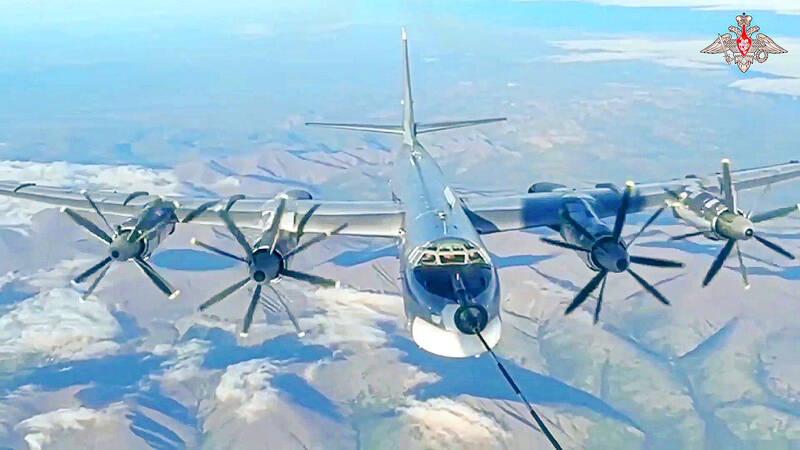A recent Sino-Russian joint air patrol conducted over the waters off Alaska was designed to counter the US military in the Pacific and demonstrated improved interoperability between Beijing’s and Moscow’s forces, a national security expert said.
National Defense University associate professor Chen Yu-chen (陳育正) made the comment in an article published on Wednesday on the Web site of the Journal of the Chinese Communist Studies Institute.
China and Russia sent four strategic bombers to patrol the waters of the northern Pacific and Bering Strait near Alaska in late June, one month after the two nations sent a combined flotilla of four warships to the Pacific Ocean via the Osumi Strait.

Photo: Russian Defense Ministry Press Service via AP
These activities marked the eighth air patrol and fourth joint naval patrol of Chinese People’s Liberation Army (PLA) and the Russian Armed Forces (RAF) since 2019, Chen said.
Although the Chinese and Russian bombers stayed in international airspace, they passed through the US-Canadian air defense identification zone near Alaska, sparking concern in Washington and Ottawa, he said.
Although the aircraft did not enter the US’ sovereign airspace, the aerial patrol signaled a boost in China’s and Russia’s capabilities in conducting joint operations, he added.
The PLA and RAF demonstrated a high level of coordination and planning in selecting the air route, fuel supply and air control arrangements crucial for ensuring successful cooperation in joint warfare and an ability to respond to developments in the battlespace, he said.
The exercise demonstrated a rising level of interoperability in information sharing and communications between China and Russia’s forces, though the exact capabilities utilized to share data are unknown, Chen said.
Moscow’s statement that Su-30SM and Su-35S fighters participated in the exercise would imply improved interoperability, as a military communication network’s complexity increases with the number of distinct aircraft types being operated, he said.
Citing information published by the US and Canada, Chen said PLA Xian H-6 bombers had used Russian air fields for refueling and maintenance, suggesting adequate coordination was achieved in logistics.
The patrol showed that the PLA’s nuclear deterrence capability has improved as the exercise brought Chinese bombers within the 200-mile (322km) striking distance of Alaska’s coastline, he said.
The Sino-Russian military cooperation reflects the increasing intensity of the competition between the two nations and the US-led coalition in the Indo-Pacific, he said, adding that Beijing considers such alliances to be necessary to counter Washington and its allies’ collective power, he said.
China’s military cooperation with Russia likely targets third parties and the US military’s presence in the Indo-Pacific region, Chen said.

The brilliant blue waters, thick foliage and bucolic atmosphere on this seemingly idyllic archipelago deep in the Pacific Ocean belie the key role it now plays in a titanic geopolitical struggle. Palau is again on the front line as China, and the US and its allies prepare their forces in an intensifying contest for control over the Asia-Pacific region. The democratic nation of just 17,000 people hosts US-controlled airstrips and soon-to-be-completed radar installations that the US military describes as “critical” to monitoring vast swathes of water and airspace. It is also a key piece of the second island chain, a string of

A magnitude 5.9 earthquake that struck about 33km off the coast of Hualien City was the "main shock" in a series of quakes in the area, with aftershocks expected over the next three days, the Central Weather Administration (CWA) said yesterday. Prior to the magnitude 5.9 quake shaking most of Taiwan at 6:53pm yesterday, six other earthquakes stronger than a magnitude of 4, starting with a magnitude 5.5 quake at 6:09pm, occurred in the area. CWA Seismological Center Director Wu Chien-fu (吳健富) confirmed that the quakes were all part of the same series and that the magnitude 5.5 temblor was

The Central Weather Administration has issued a heat alert for southeastern Taiwan, warning of temperatures as high as 36°C today, while alerting some coastal areas of strong winds later in the day. Kaohsiung’s Neimen District (內門) and Pingtung County’s Neipu Township (內埔) are under an orange heat alert, which warns of temperatures as high as 36°C for three consecutive days, the CWA said, citing southwest winds. The heat would also extend to Tainan’s Nansi (楠西) and Yujing (玉井) districts, as well as Pingtung’s Gaoshu (高樹), Yanpu (鹽埔) and Majia (瑪家) townships, it said, forecasting highs of up to 36°C in those areas

IN FULL SWING: Recall drives against lawmakers in Hualien, Taoyuan and Hsinchu have reached the second-stage threshold, the campaigners said Campaigners in a recall petition against Chinese Nationalist Party (KMT) Legislator Yen Kuan-heng (顏寬恒) in Taichung yesterday said their signature target is within sight, and that they need a big push to collect about 500 more signatures from locals to reach the second-stage threshold. Recall campaigns against KMT lawmakers Johnny Chiang (江啟臣), Yang Chiung-ying (楊瓊瓔) and Lo Ting-wei (羅廷瑋) are also close to the 10 percent threshold, and campaigners are mounting a final push this week. They need about 800 signatures against Chiang and about 2,000 against Yang. Campaigners seeking to recall Lo said they had reached the threshold figure over the